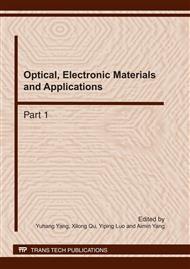p.368
p.373
p.378
p.383
p.388
p.393
p.397
p.402
p.409
Forecast and Processing of Weak Electrical Signals in Clivia miniata by RBF Neural Networks
Abstract:
Original weak electrical signals in Clivia miniata were tested by a touching test system of self-made double shields with platinum sensors. Tested data of electrical signals denoised by the wavelet soft threshold and using Gaussian radial base function (RBF) as the time series at a delayed input window chosen at 50. An intelligent RBF forecasting system was set up to forecast the signal in plants. Testing result shows that it is feasible to forecast the plant electrical signal for a short period. The forecast data can be used as an important preferences for the intelligent automatic control system based on the adaptive characteristic of plants to achieve the energy saving on agricultural production both the greenhouse and /or the plastic lookum.
Info:
Periodical:
Pages:
388-392
Citation:
Online since:
March 2011
Authors:
Price:
Сopyright:
© 2011 Trans Tech Publications Ltd. All Rights Reserved
Share:
Citation:


